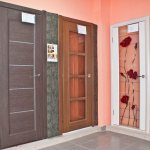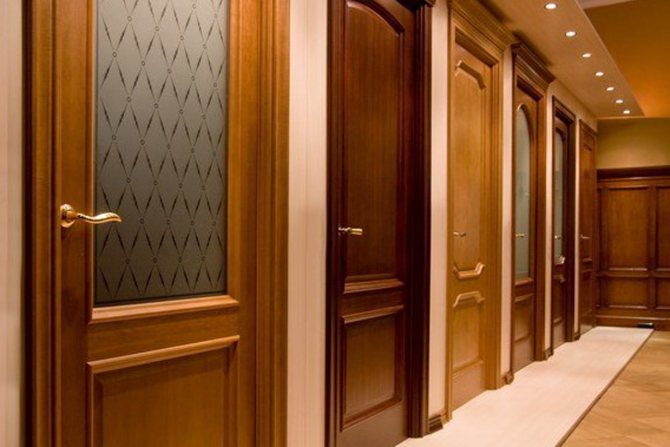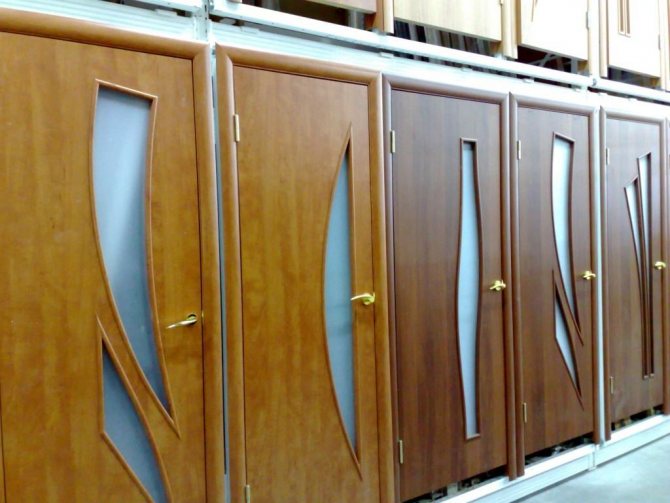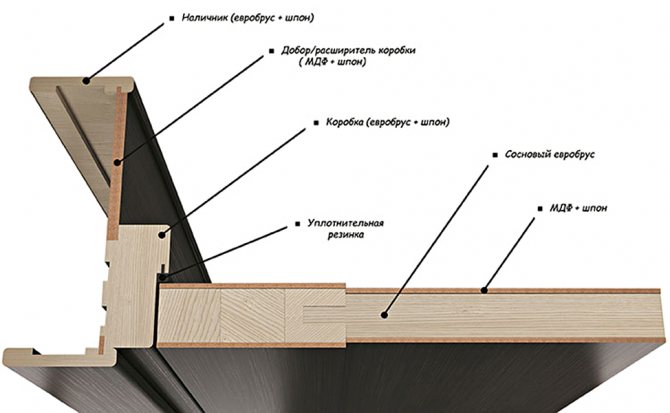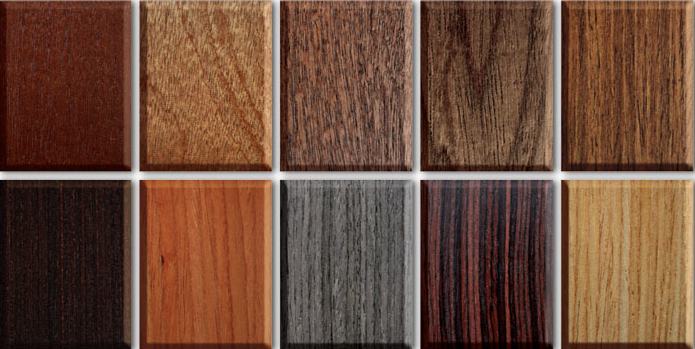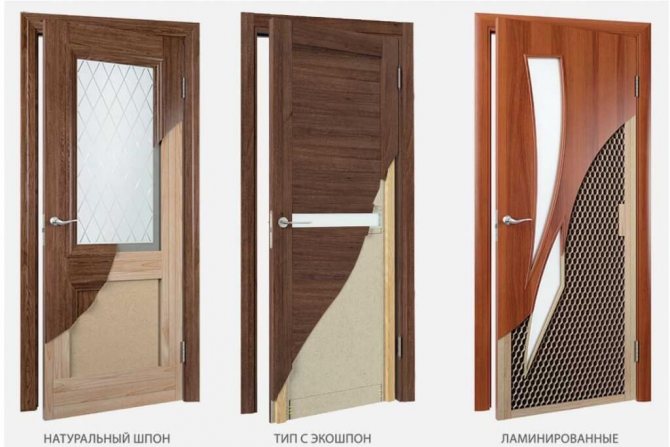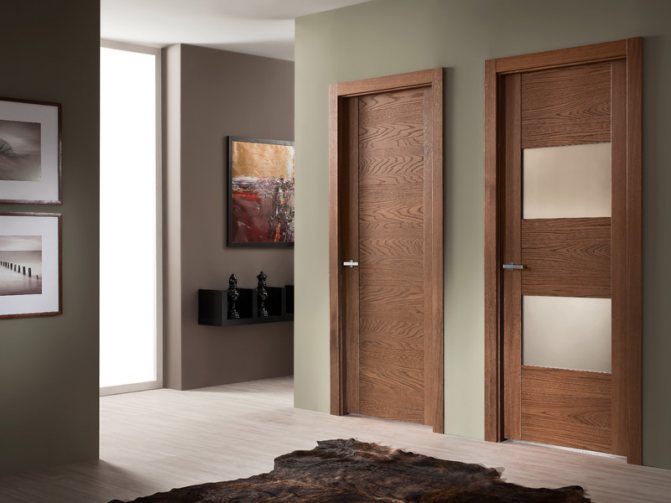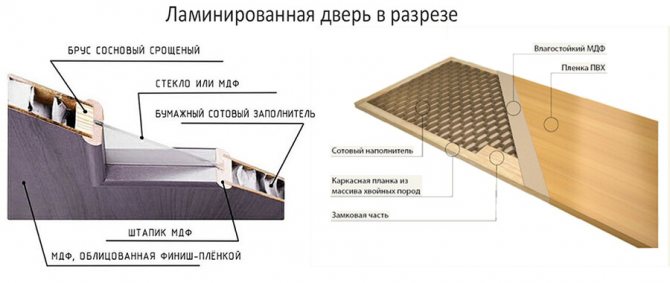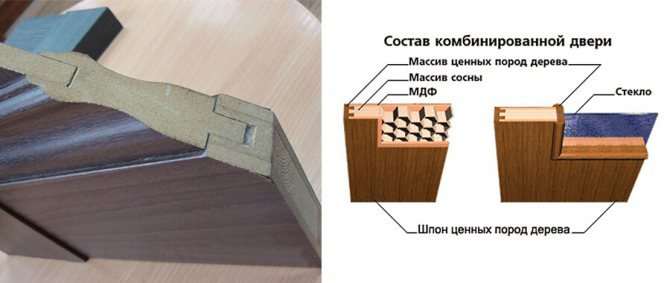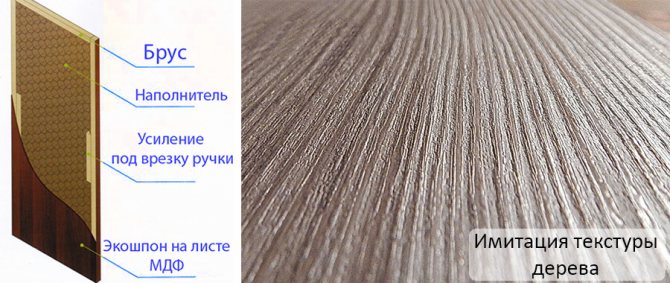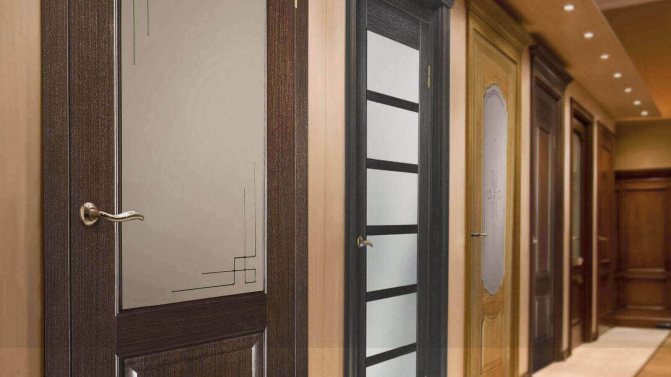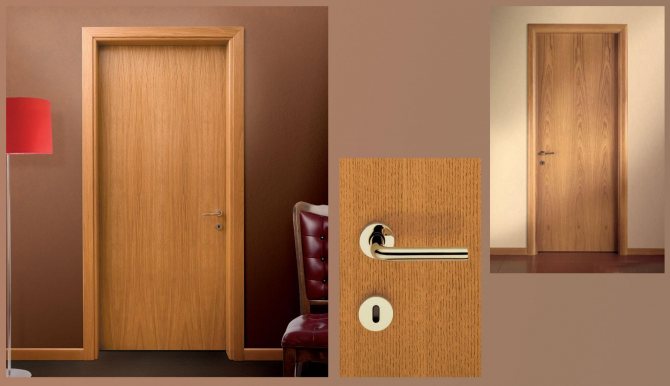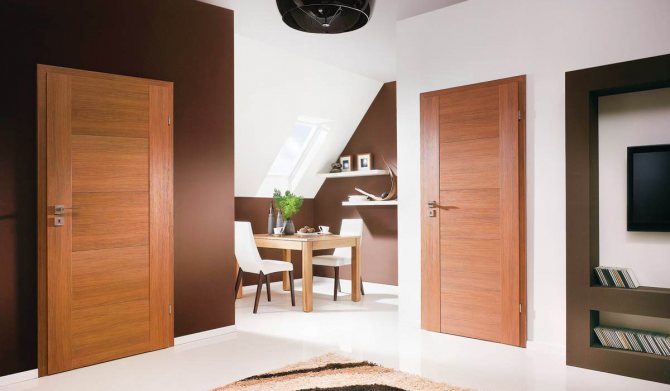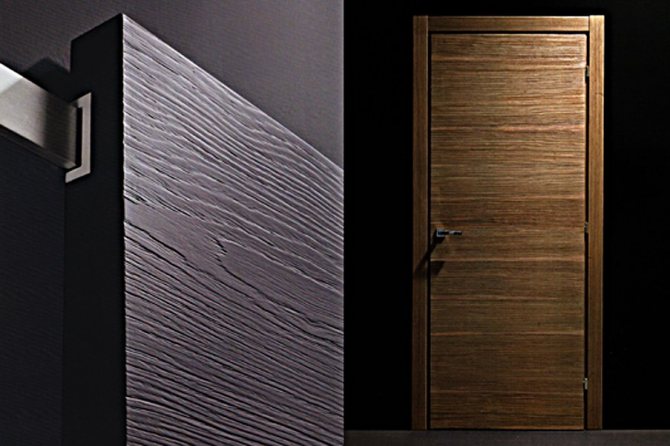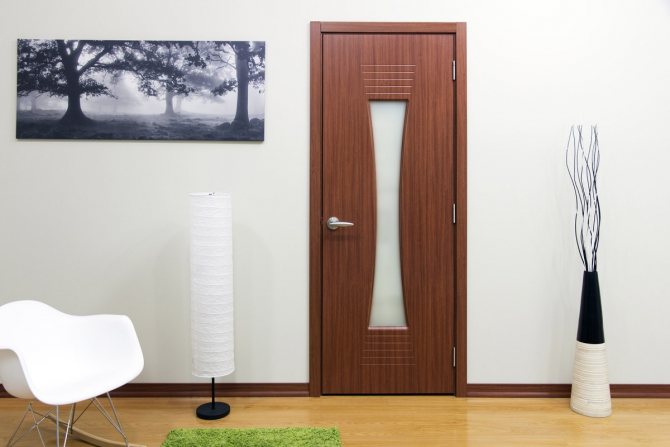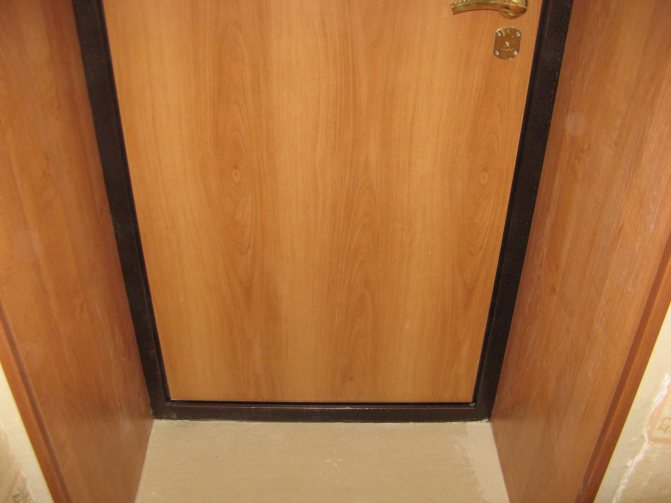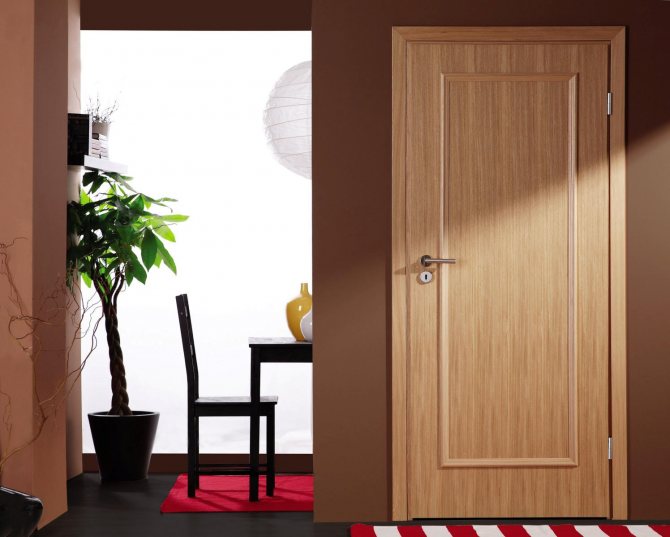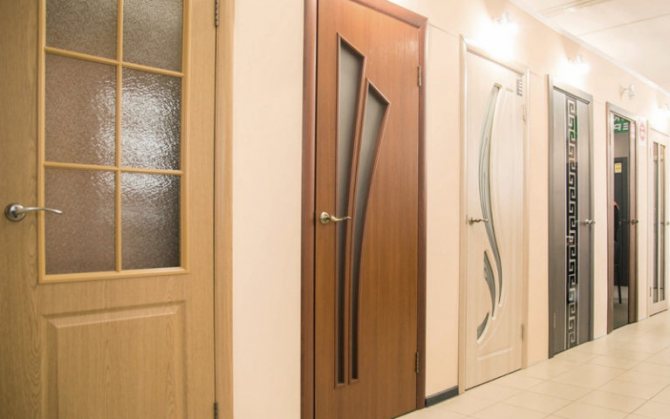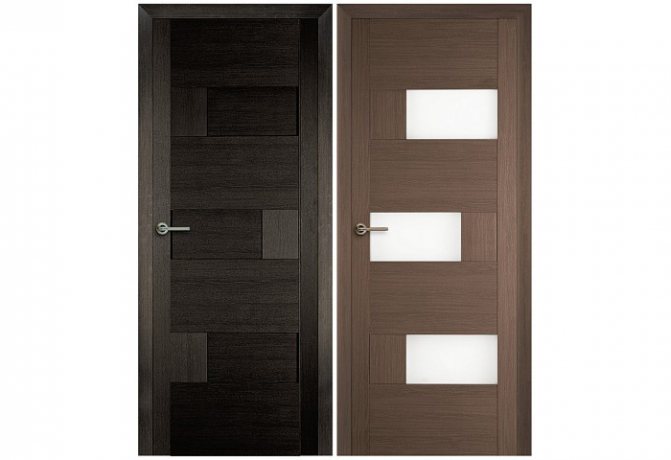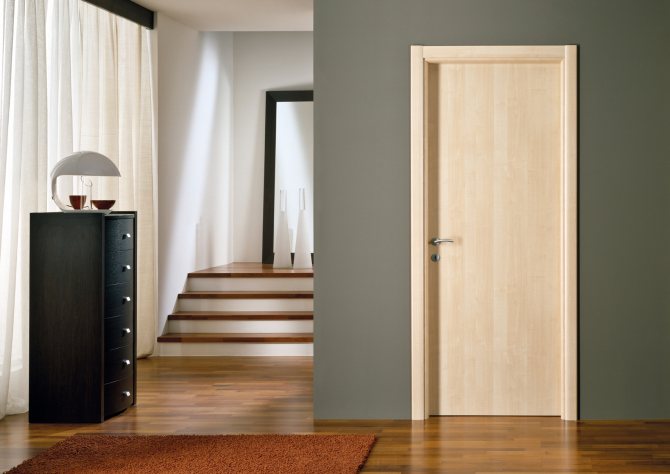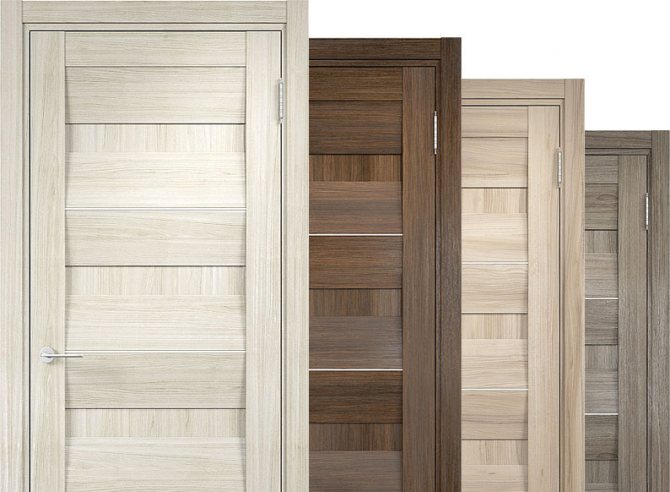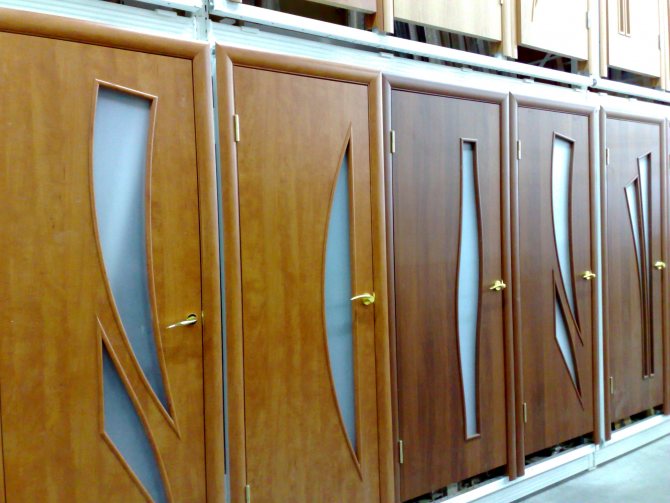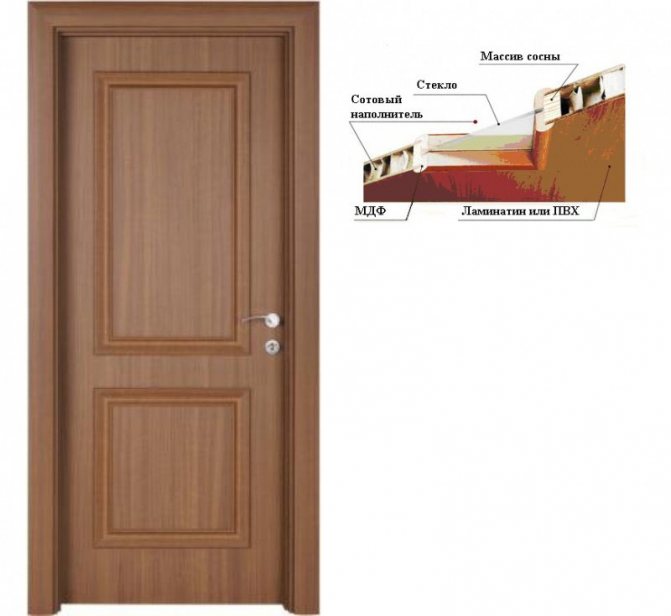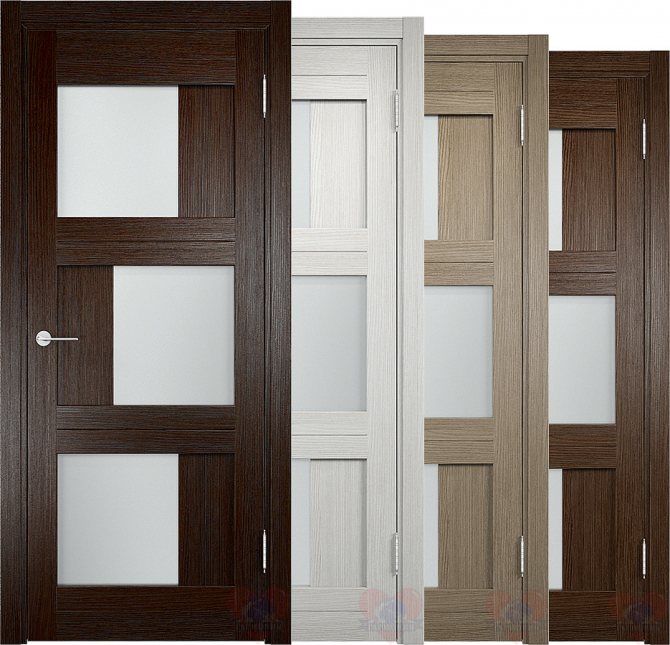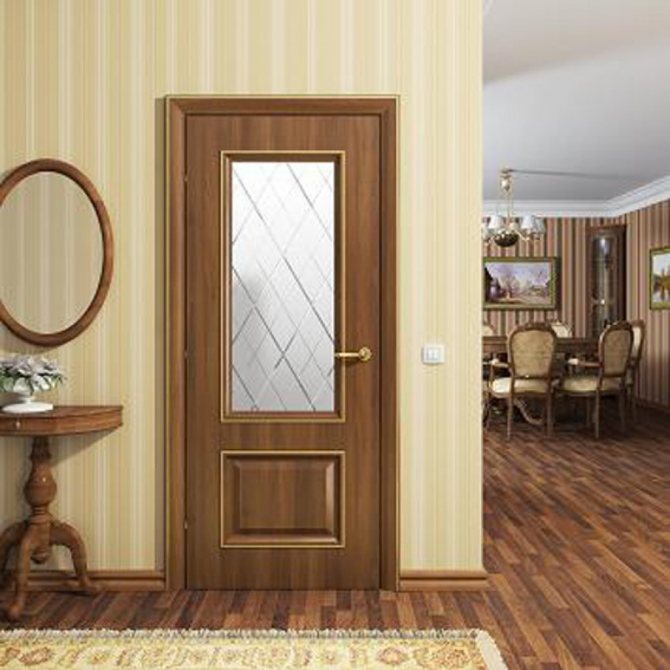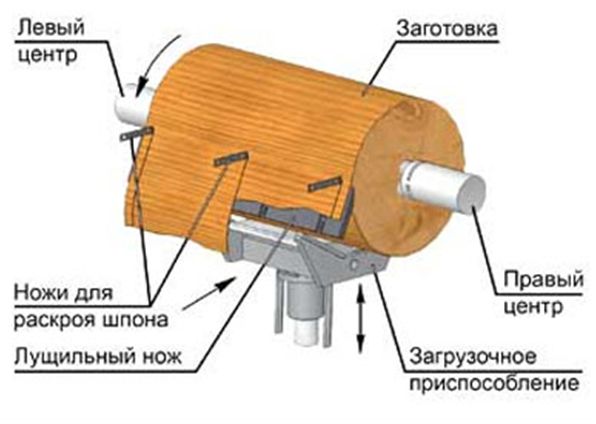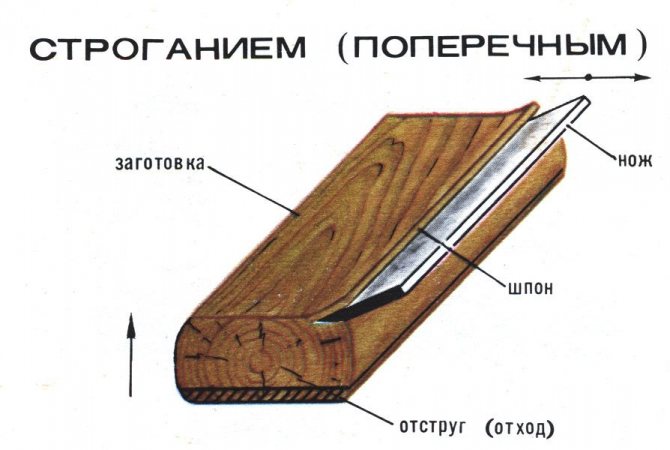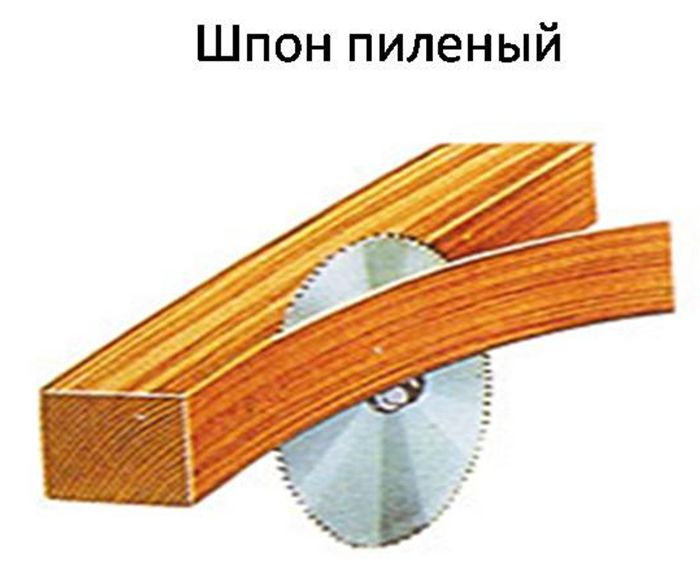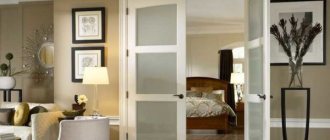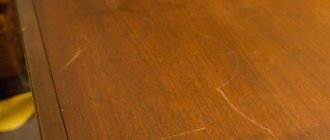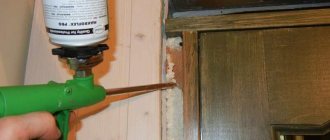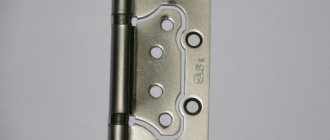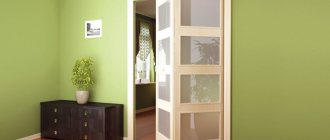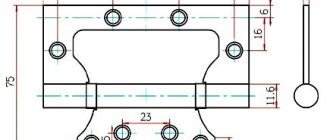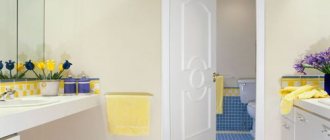Doors are a significant piece of interior design that performs not only a practical, but also a decorative function. That is why the combination of aesthetics and high performance characteristics is so important in these products. At the moment, there is a wide variety of types of doors. They differ in composition, production technology and, as a result, durability.
In this article, we will compare fairly popular products made with veneer and laminated film. Let's find out which is better: laminated or veneered doors?
Veneer
So, veneer is a cut of natural wood, removed from wood by planing or sawing. Veneer can be made from a wide variety of wood species. Mostly it is soft wood (fir, pine, alder, linden) - a budget option. Oak, mahogany, European or American walnut, merbau, wenge will cost more. Well, the most expensive exotic options are rosewood, ebony, camphor, bubingo and others.
Veneered doors have a traditional wood texture and color. If we are talking about fine-line veneer - a material formed from blocks of peeled veneer, then the coating can imitate a brighter texture.
Veneered doors are more expensive than chipboard doors, but cheaper than solid wood doors.
Again, the price of a veneered door depends on the nature of the manufacture of the door leaf. This could be:
- hollow structure in the form of a three-layer "cake" with a honeycomb filling inside
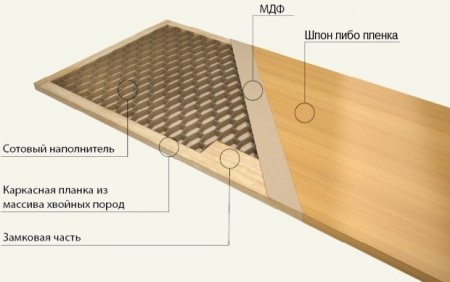
- solid construction - solid pine log
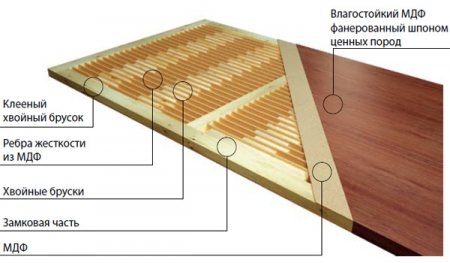

As you probably already guessed, a solid canvas will cost more. It is also more durable, but it also has its drawback - the structure is heavier than the hollow door, which creates an additional load on the frame. In other matters, with a quality installation, operational problems usually do not arise.
Interior doors: characteristics and types
The appearance of an interior door, the type of its finish and what it is made of can inform about the financial situation of the apartment owner. You can have ideal components of the house: furniture, appliances, but if the door does not fit into the interior, it will be old and shabby, the house will not be comfortable.


The type of interior doors is different:
- Swing
... An ordinary, familiar door to every room. Has one or a couple of canvases. - Sliding
... The most comfortable type. Suitable for narrow spaces. Such doors move parallel to the wall during opening. The downside is the lack of sound insulation with thermal insulation. - Pendulum
... A door that can be opened inwards as well as outwards. The leaf of such doors is attached to the walls and floor. In the absence of a door frame, installation is easy, but there is also no sound and heat insulation. - Folding
... Opening and closing is done like an accordion. They look very nice, but they cannot be installed everywhere. Suitable for dressing rooms, beauty salons and massage. - Rotating
... Suitable for shopping malls, hotels, offices, etc. The design and installation are complex. For those who prefer an exotic interior, it can serve as a good interior door.
For a residential building and apartment, a swing door type is best suited. When choosing a specific model, it is necessary to take into account that all doors have the same look, color and finish, and also match the style with the overall interior.
In order not to be mistaken when choosing an interior door, you need to be aware of some points with which you can purchase the best model.
Main technical characteristics of doors:
The quality of heat and sound insulation.
For the second item, a seal must be available. It will help protect the room from dust and unpleasant odors. A door with a honeycomb filling is the lightest. A custom-made door is an excellent option. At the same time, you can follow the process of its manufacture, choose the material and design with the required style.
Laminate
For the production of laminated door covering, a special impregnated film based on melamine or acrylic (0.2 mm), as well as synthetic veneer (laminate) (0.4-0.8 mm) can be used. Among the disadvantages of melamine laminated film is a thin coating layer, the content of toxic substances in the impregnation resins and not always high-quality adhesion to the door leaf. Laminatine is thicker, has a low level of water absorption and is able to withstand temperatures from -40 to +80 ° C, does not emit toxic fumes during combustion.
In this case, the price is again directly proportional to the quality and characteristics of the coating.
The second moment that affects the cost of the door is the filling of the leaf. For interior laminated doors, hollow versions with a cellular structure made of corrugated cardboard in the inner cavity are often used. Plus - the door is light, from the point of view of thermal insulation it is not much different from veneered doors. For typical apartments, this is a good budget option. The downside is the low level of sound insulation, which, however, is easily solved by installing a seal.
Coating technology
Let's consider how such doors are made. Veneered doors consist of an MDF base and a wooden frame. On top, a coating is applied that imitates an array, that is, veneer. In order for it to securely adhere to the surface, special adhesives are used. To remove the slightest air bubbles, the workpiece is placed in a heat chamber, where the gluing process takes place under pressure at a high temperature.
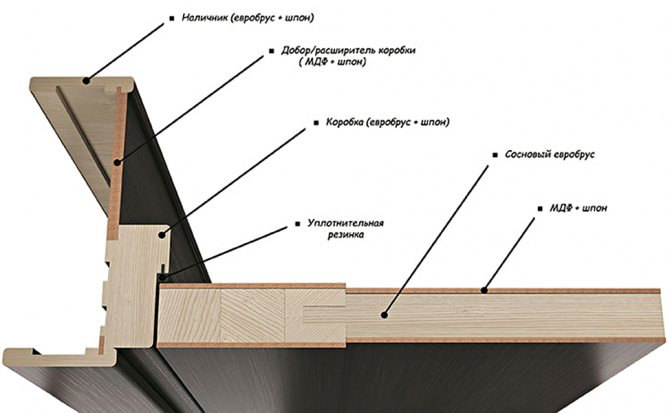

Sectional diagram of a veneered door
Laminated models are finished exclusively under the influence of temperature. In order to process the embossed protrusions, you need to warm up the material well and press it against the door on the glue base under pressure.
In both cases, the edges of the doors are closed by the edge. It can be a base material or a plastic strip. In order to understand which is the best, it is important to check the quality of edge gluing. It is also fixed by using high temperature due to the presence of an adhesive backing on the back.
To protect the decorative coating, varnish is applied on top. Laminated models are often pre-treated in this manner. Veneer can be processed both in advance and on the finished product.
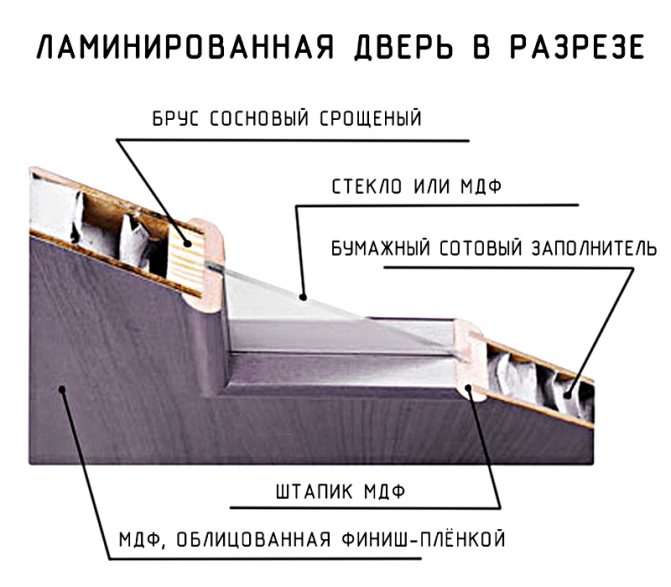

Door lamination occurs under the influence of temperature
What is the difference between laminated doors and veneered doors?
We have already discussed the main differences above. However, how to distinguish a veneered door from a laminated one in appearance? Not every buyer can do it right away, and some unscrupulous sellers take advantage of it. Let's take a look at the key visual differences in order to come to the store fully armed.
1) Laminated doors are smooth and shiny. Veneered, even in spite of the varnish coating, have a rough surface and do not shine.
2) In the store you can find several laminated doors that are exactly the same in color and texture. But it is almost impossible to find even two veneered doors that are exactly the same in color and texture.
3) Another easy way to distinguish a veneered door from a laminated one. Tap on the canvas.A veneered door is usually more massive, therefore it sounds more muffled. The sound from knocking on the laminated sheet is, accordingly, more sonorous.
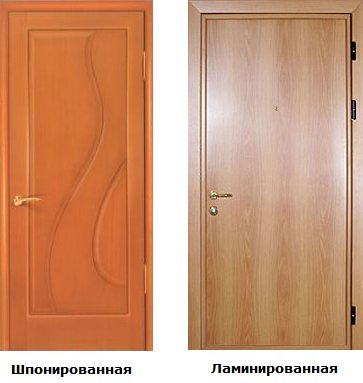

Now you know the difference between laminated doors and veneered doors, and you can easily differentiate for yourself the options presented in the store.
What is important to know when buying
Good manufacturers of laminated doors take the final quality of their products very seriously. As a rule, they are produced on European equipment that meets all the requirements, and only high-quality materials are used.
Despite all this, the buyer may still be faced with a substandard, bad door. In order for the consumer to avoid such an unpleasant situation, he should be aware of what information must be obtained during the purchase.
So:
First, the buyer needs to know what the door is covered with. A lot depends on the quality of the coating.
The only good thing about doors with such a coating is their extremely low price. When in salons, buyers are offered to purchase an unusually cheap interior door, it is worth expecting that it is with such a coating, and therefore it is pointless to demand special durability from it. Everything that has been reported in this article about laminate is related to a coating called double-sided laminate. Such a polymer film is particularly durable, does not change its color and does not get scratched.
We advise you to study - The procedure for repairing an apartment: what is behind what and why
The doors are covered with it using a special technology, and therefore the film is reliably glued and does not peel off over time. The most expensive and, which is very important, strong and durable material for door covering is continuous pressing laminate or CPL plastic. This door laminating coating is particularly durable and resistant to wear. It is because of this quality that doors with such a durable coating can be used in public places where their operation is very far from careful.
First of all, before buying, it is important to decide on the design. After all, it can be quite different. Look at the photo and select
The instructions on the door must also be read.
Pay attention to how much moisture they can tolerate and how reliable it is. After that, you can make a choice
Which doors are better - veneered or laminated
When making a difficult choice, always proceed from the sum of the pluses and minuses of both options. We have already covered some of them. But still, which interior doors to choose - laminated or veneered.
Natural veneer is definitely better - it is more environmentally friendly, safer, of higher quality. But it is also more expensive, here already focus on your financial capabilities. Of the minuses, again - the heterogeneity of the structure (you cannot pick up exactly the same doors) and the need to maintain optimal microclimatic indicators in the room, which is not always possible in the conditions of the Russian climate.
A laminated door is cheaper, however, it is far from being environmentally friendly. At the same time, laminate is more environmentally friendly than melamine film, and perfectly tolerates temperature extremes. In addition, such a coating is easier to care for than veneer. Of the minuses: strong side impacts can cause shedding of the edge of the laminate, artificial origin repels many buyers.


These are the differences between laminated doors and veneered doors. You now have the background information to help you make the best choices.
We would also like to draw your attention to the fact that with all their functional disadvantages, doors can be made with high quality. It all depends on the manufacturer, the equipment used and the quality of the raw materials.
Choosing doors
Recently, the Russian market has been replenished with interior doors with synthetic coating elements.What is better veneered or laminated doors, you can only decide when you know what it is.
So:
- The first door models were covered with melamine paper, which the furniture industry shared with. Due to its very low thickness, only 0.2 mm, the material is suitable for covering profiles with a large curvature. Such a coating was characterized by the likelihood of texture and natural color, which did not differ from wood. The negative aspect consisted in the fact that the coating had poor adhesion to the base, it was not very well cleaned, and often it was covered with cracks in some areas that had curvature.
- Soon, melamine paper was replaced by a material (new from the furniture industry) - 2-chrome laminate. It had a slightly greater thickness (from 0.4 to 0.8 mm), was distinguished by resistance to mechanical stress, and was also characterized by an improvement in aesthetic characteristics, which in total determined its consumer popularity.
- Most of the products sold in our country are covered with laminate. It is applied to the main surface using cold glue technology, which allows laminate strips of different finishes to be glued to door elements.
- Today, the top manufacturers of laminated doors are conducting all sorts of experiments, the ultimate goal of which is to find more attractive solutions to improve the exterior of products.
- Modern technologies allow us to reach new heights in four-color printing, thanks to which laminate becomes a progressive coating (there is no official name yet), with a color identical to natural veneer, and having improved resistance to mechanical stress. It is too early to judge whether laminate flooring will gain widespread popularity among consumers.
Further, it makes sense to consider in more detail the advantages and disadvantages of both laminate and veneer, so that it would be easier for each buyer to determine for himself the appropriateness of using this or that material.
The main advantages of doors with an eco-veneer
- Wear resistance. For the production of eco-veneer, only natural fibers of trees are used, which are painted in the required color. In addition, they are glued together with a polymer composition. As a result, the resulting material is not afraid of heavy loads for a long period of time, does not scratch during operation, and is resistant to various damages.
- Variety of colors. Eco-veneer can be painted with artificial paints. This action cannot be performed with natural wood. As a result, doors made from this material are available on the market in a wide range of colors. And often you can find original and unique shades.
- Ease. The artificial veneer has a very low weight. Therefore, doors finished with this material turn out to be very light, and experts strongly advise using them in rooms in which there are thin-width partitions between rooms and large doors cannot be installed.
- UV protection. The sun's rays cause the tree to catch fire faster, which requires special protection. And doors made of artificial veneer can be installed in any room that is illuminated by the sun. Eco-veneer does not fade, retains its shape after exposure to ultraviolet rays.
- Beautiful texture. A simple tree cannot boast of such a pronounced surface as an eco-veneer. The material is pleasant to the touch; when you touch it, you can feel thin wood veins under your fingers.
- Low cost. Recently, buyers have become accustomed to saving. They are already trying to get the cheapest doors. Door leaves made of eco-veneer fall into this category. But their quality and beautiful appearance are becoming a more weighty argument than low price.
- Consistency of quality characteristics in dry and humid environments.Natural wood doors crack quickly in dry rooms. And canvases made of artificial veneer can be safely installed in the bathroom, kitchen.
- Complete security. There are no poisonous compounds in the eco-veneer.
- Easy to care for. Door leaves made of this material do not absorb dirt. They can be wiped off regularly with a wet sponge.
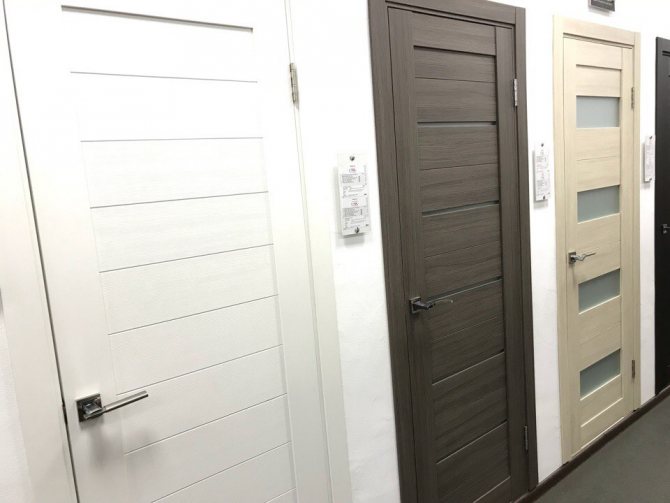

disadvantages
Among inexpensive doors, products made of this material are second only to wood canvases in strength. The covering of the eco-veneer will be seriously damaged after being hit with a sharp object. Damage received cannot be repaired. This material does not have good soundproofing characteristics. Eco-veneer door panels have poor air permeability, which is due to the presence of a polymer component that connects the fibers of the material. To solve this problem, you need to constantly ventilate the room. After analyzing all the advantages and disadvantages of interior doors made of eco-veneer, we can conclude that from this material you can get a high-quality product that is attractive to buyers in terms of price.
The cost
The simplest laminated doors with a discreet design cost about 1200-1400 rubles. If you add the cost of panels and various glass inserts, the price can increase to 3,500 rubles or more.
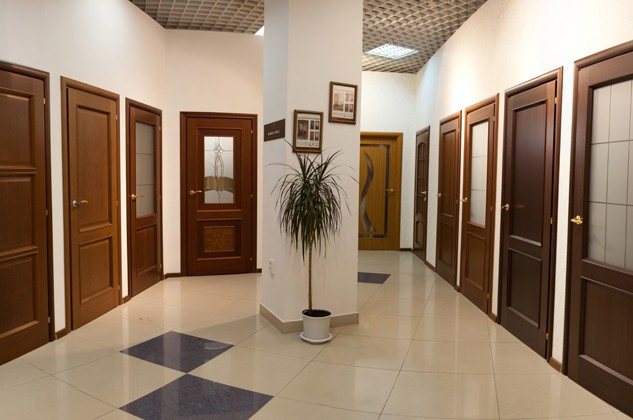

Trying to mislead the buyer, catalogs often indicate the cost of a door leaf without platbands and a door frame, significantly lowering the final price.
Also, do not forget to calculate the cost of installing laminated doors if you do not plan to install them yourself. The work will cost about another 2,000 rubles.
It is better to immediately change all interior doors in the house, since their models are constantly changing and they can be discontinued, or the shade of the old door does not match with the new door. And doors of different tonality may not make the best impression.
Skirting boards and platbands
Having realized which solid or veneer doors are better, pay attention to the skirting boards: these elements can emphasize the doorway, separating it from the rest of the interior, or, conversely, make all the objects in the room harmonious.
The dark door and light skirting go well together. But if you have chosen a light canvas, and the laminate in the room has already been laid in a dark one, it is better to use a plinth to match the door, so the opening will look whole. The dark platbands framing the canvas emphasize the contours of the opening. In rare cases, the plinth is matched to the color of the furniture.
We hope our tips have helped you make the right choice. We are waiting for you on the site Warehouse doors 169.ru ". We ourselves produce canvases from veneer, solid wood and other materials, therefore we offer only high-quality doors at affordable prices! Call us!
Back to the list
What is veneer and what types it is divided into
Initially, it is customary to call a cut of natural wood with a thickness of 1 mm to 10 mm as veneer. Accordingly, veneering is the gluing of a base with veneer, in this case, doors.
Veneer production
While some are trying to present veneer finishing as something new, in reality this production has been around for about 150 years. Suffice it to say that the well-known plywood is 100% made of veneer. There are 3 ways to dissolve wood into thin sheets.
| Illustrations | Recommendations |
| Peeling The most common way. During peeling, the workpiece (log) is fixed on both sides, after which, during the rotation of the workpiece, the knife cuts the specified thickness of the massif. On average, the thickness of the peeled sheet ranges from 1 to 3 mm. |
| Planing Here the log is fixed motionless, and the knife moves and cuts layer by layer. There is a transverse and longitudinal planing. The planed sheet has a thickness of 3 - 5 mm. In terms of quality, this material is better than peeled, but its cost is higher. |
| Sawing In the manufacture of a sawn sheet, the log is dismissed not with a knife, but with a circular or band saw. Such production has a huge percentage of waste and a high cost, therefore it is used extremely rarely, but only in this way it is possible to cut veneer with a thickness of 5 mm to 10 mm. |
What kind of veneer do the doors cover
Until the eighties of the last century, veneer was exclusively natural, but then, gradually, technical progress reached this industry, as a result, now we have 4 common types of door veneer.
- Natural. We have already mentioned about natural wooden sheets, let's just say that there is peeled or planed material on the door, sawn sheets can be used fragmentarily to decorate the canvas.
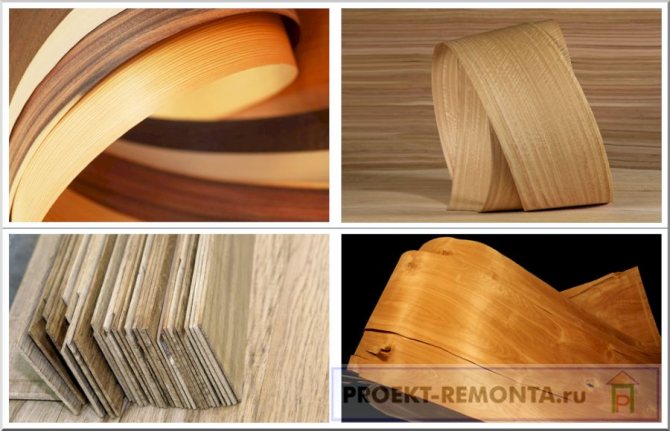

Natural veneer finish is one of the most demanded
Important! If the technology is observed, the door leaf covered with natural veneer visually does not differ in any way from full-fledged wooden doors.
- Multi-veneer. This material is also called reconstructed. For its production, woodworking waste is used. The appearance here is certainly original, but this coating only vaguely resembles wood. Below in the photo, options for multi-veneer are shown, of which the texture of woven fabric is considered the most popular.
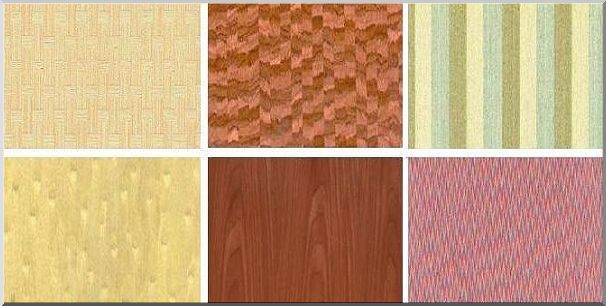

Multi-veneer is an order of magnitude cheaper than natural sheet, but such material is not suitable for every interior
- Fine-line. In a nutshell, fine-line is a natural veneer that was cut from budget wood, then processed and impregnated with paint. As a result, the leaf has acquired the appearance of some elite wood species. The material has an average price and good characteristics; now fine-line is rapidly gaining popularity.


Fine-line technology allows converting inexpensive wood into elite varieties of wood for reasonable money
- Eco-veneer. The Germans invented this curiosity about 20 years ago. The material is positioned as environmentally friendly and natural. In reality, the sheet is made of wood dust on a polymer binder, in fact it is plastic with the addition of wood.
Advice! Imported goods with the prefix "eco" should be treated with caution. For example, German doors with an eco-veneer are one and a half times more expensive than domestic ones, but buying Russian or Belarusian doors, a person gets natural wood, and in the case of a European product, we are dealing with good plastic.


When choosing domestic doors or eco-veneer from Europe, it should be borne in mind that in the first case you get natural wood, and in the second, high-quality plastic that copies wood
Methods for veneering doors
When choosing a product, it will not be superfluous to ask how the finish was applied to the canvas. There are 3 options for veneering doors.
- Cold pressing. The base is greased with glue, after which it is covered with veneer and placed under a conventional press. The simplest equipment is used, in fact, such a workshop can be organized even in your own garage. The work is done quickly, but the quality is below average.
- Hot pressing. The instructions are the same as for pasting, using the cold method, only the press sole is hot, and the glue is special. The method allows the production of high-quality goods at a relatively low cost. More than half of domestic factories use hot pressing.
- Vacuum gluing. The latest squeak of fashion in veneer door trim. Vacuum gluing allows you to veneer products with complex relief, plus the quality of fixation here is an order of magnitude higher than the two previous options.
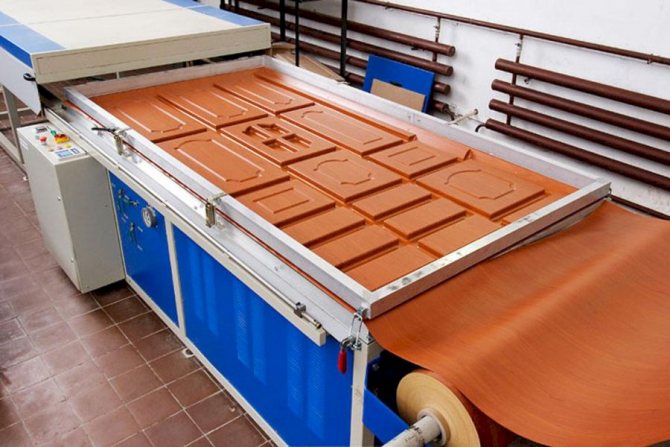

Vacuum veneered doors have high performance characteristics, plus this equipment allows you to veneer canvases with any relief
